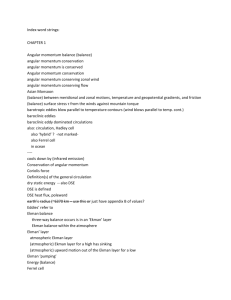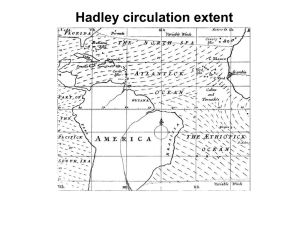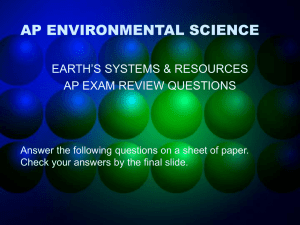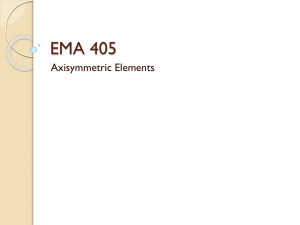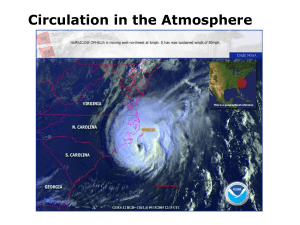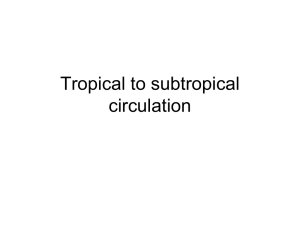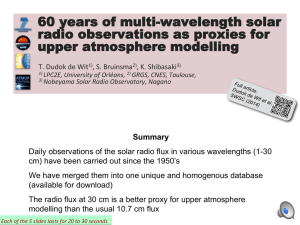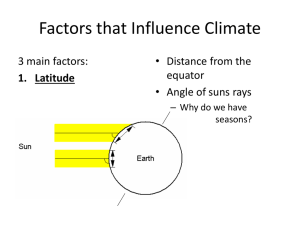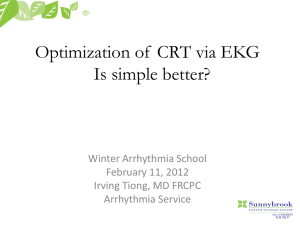The General Circulation of the Atmosphere
advertisement
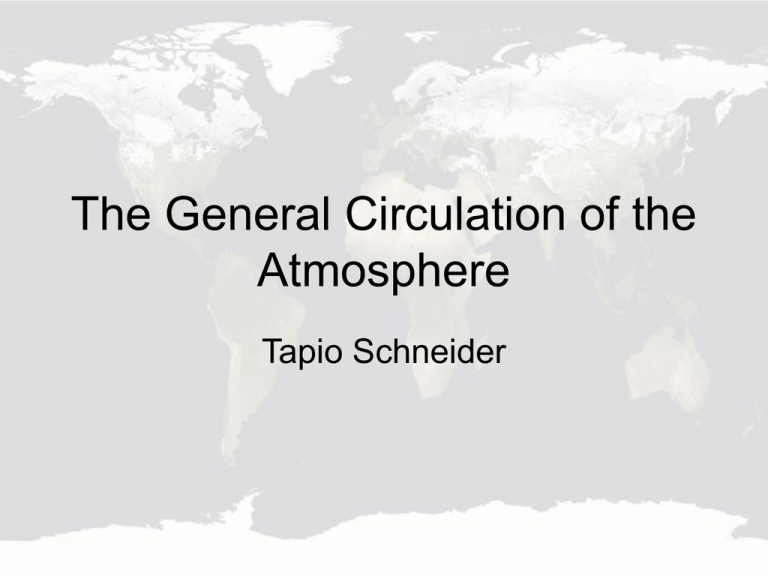
The General Circulation of the Atmosphere Tapio Schneider Overview • Aims • Axisymmetric features of Earth’s atmosphere • Tropical Hadley Circulation – Hide’s theorem • Extratropical Circulation • Atmospheric Macroturbulence http://www.gps.caltech.edu/~tapio/papers/annrev06_supp.html Aims • Require a theory of general circulation of the atmosphere to produce models of the Earth’s atmosphere, both past, future and for atmospheric models of other planets. • A general circulation theory for idealised atmospheres with axisymmetric rotations is a prerequisite for any future more complete, general circulation theory, which must be reducible to this canonical case. • To draw attention to unresolved, fundamental questions about the general circulation of dry atmospheres, questions whose resolution is a prerequisite for any general circulation theory, moist or dry. Axisymmetric Circulation Temporal and Zonal Circulations Axisymmetric Flow • Proposed by Hadley • Axisymmetric circulation baroclinically unstable • Eddies transport heat polewards Macroturbulence • Mactroturbulence – large scale eddies, +1000km. • Eddies produced by baroclinic instability. • Transport angular momentum into latitude zones in which they are created. • Angular momentum flux into zone compensated by surface drag surface westerlies appear in baroclinic zones into which angular momentum is being transported. • Vertical structure of winds and strength of upper level jets linked to surface winds by thermal/gradient wind balance. Thermal Wind • Relates vertical shear of the zonal wind to meridional temperature. • Not actually a wind, but the difference in the geostrophic wind between two pressure levels p1 and p0, with p1 < p0. • Only present in an atmosphere with horizontal gradients of temperature i.e. baroclinic. • Flows around areas of high and low temperature as the geostrophic wind flows around areas of high and low pressure. Axisymmetric Circulation Vs. Macroturbulence Explanation of Figure 3 • Bottom row fig 3 temporal and zonal means of mass flux stream function and angular momentum in steady states of macroturbulent circulation that correspond to the axisymmetric circulation in top row. • Macroturbulent Hadley cells extend further poleward than axisymmetric simulations. • Streamlines in upper parts of Hadley cell cut angular momentum contours. • Local Rossby numbers reduced relative to axisymmetric circulation. • Eddies strengthen the equinoctial Hadley cells (3a and 3b) and weaken the winter cell (3b and 3e) • Mass flux in Hadley cells in macroturbulent model same order of magnitude as in Earth’s Hadley cells. • When max heating moved to 6 degrees latitude, winter cell 1.5 times bigger and summer cell 1.5 times smaller (3d and e). Implications of Hide’s Theorem • u <= um = Ωa sin2 ()/cos() • Assume gradient-wind balance, then from meridional momentum equation: • Ф <= 2 Ω2 a2 3 Ф=gz, (assuming small latitude = tropics) • Use ideal-gas result p = p0 exp(-Ф/RT) (T is vertically averaged) • => constraints on meridional decrease in temperature • Assume T ~ h cos2 • Then Hadley circulation extends to • m ~ sqrt (gz* h) / (Ω2 a2 T0) h = pole-equator T difference Meridional Extent of Hadley Cells Potential Vorticity & Entropy Entropy – measures amount of disorder in a system • For an ideal gas: s = cp ln (T p –R/c ) • = 0 exp(-s/cp) • constant s constant Potential vorticity – measure of vorticity, normalized by entropy • P = (planetary vorticity + relative vorticity) / (width of entropy contour) = (f + )/H • Conserved quantity for adiabatic processes Isentropic Mass Circulation Extratropical flow ~ large-scale eddies ~ adiabatic convenient to use isentropic coordinates Entropy transported poleward Eddy entropy flux >> mean entropy flux Eulerian mass flux Isentropic mass flux Isentropic, meridional mass flux Isentropic eddy flux of potential vorticity P Eddy flux of at sfc (boundary term) Assume eddies mix P downgradient & P>0 in interior southward P flux … i Ekman mass flux b Turbulence as a diffusive process • Assume eddies mix potential vorticity & potential temp. diffusively • Assume there is e so that above e, atmos. is in radiativeconvective equilibrium. Integrate previous eqn. LHS vanishes, ignore Ekman flux • up to which entropy fluxes are significant – this level must be lower than the tropopause pe >= pt find 1 bulk stability supercriticality – measure of vertical extent of eddy entropy fluxes Supercriticality constraint x-axis – negative gradient ~ entropy gradient y-axis – bulk stability Sc<1 regime – eddy entropy fluxes weak, tropopause set by radiation/convection Sc~1 regime – eddy entropy fluxes large & stabilize the thermal stratification tropopause height adjusted A state with strong nonlinear eddy-eddy interactions (Sc>>1) adjusts thermal stratification so that Sc<~1 (and has weak eddyeddy interactions) Summary • Differential heating causes Hadley circulation in tropics, Polar cell near poles • In midlatitudes, differential heating causes baroclinic instability • Hide’s Theorem imposes upper limit to Hadley circulation extent • Extratropical circulation associated with (adiabatic) eddy fluxes of P, • If eddies act diffusively, supercriticality <=1 – thermal stratification / tropopause height linked to eddy strength
